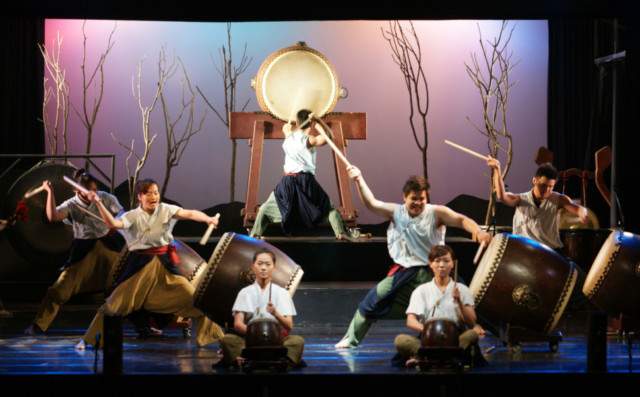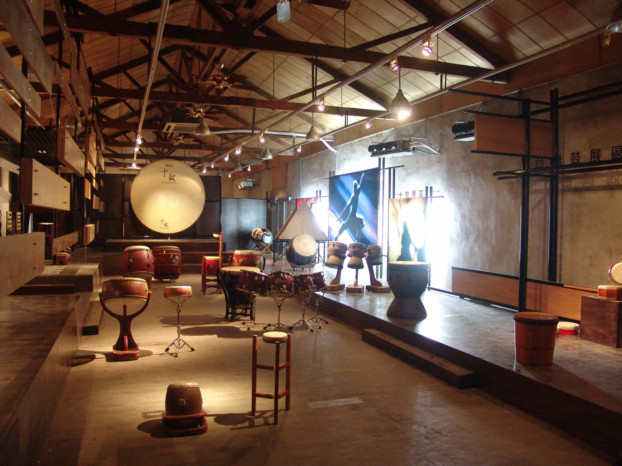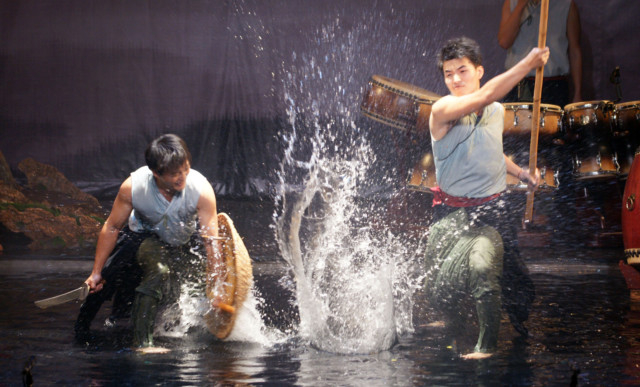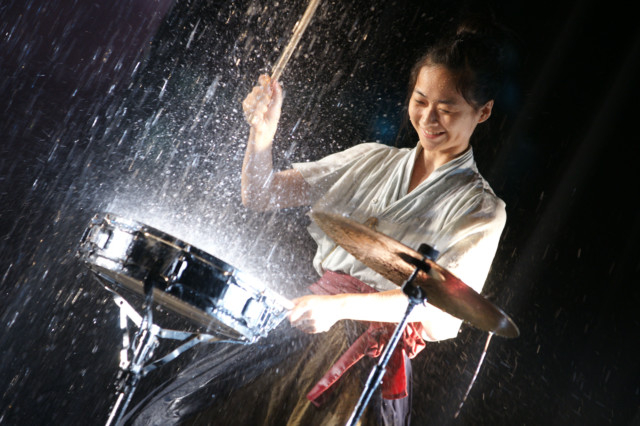
Ten Drum Cultural Village, one of Taiwan’s most popular cultural destinations, is a former sugar mill converted to a drum centre. It has an iconic chimney towering above a picturesque compound landscaped with Bauhinia trees skirting Koi fish ponds, contemporary as well as traditional sculptures and art installations. One moment you stumble upon complete stillness in the womb of mother earth while touring erstwhile bomb shelters, yet another moment outside the bomb shelter in a sophisticated auditorium the peace is shattered with thunderous drum strikes. Today an art hub, this old sugar-industry site in Kaohsiung City’s Qiaotou District is a historic monument with real bomb shelters built during the American invasion of Japan (those days Taiwan was a Japanese colony).
Grammy Award-nominated Ten Drum Art Percussion Group has created this fascinating culture park centred on traditional drumming on this site of a former sugar refinery situated in the heart of Tainan County. The troupe’s ultimate goal is to see Taiwan one day as a celebrated drum-music land.
Drum Culture
Taiwan is closely associated with its tribal drumbeats. During temple rites, massive mechanised thuds alternate with the tolling of a bell. When chanting, Taoist priests keep up a constant tick-tocking on small drums. During the solemn rites every September at Taiwan’s Confucian temples, drums of five different sizes are played.
Ten Drum’s founder, 1972-born, Hsieh Shih has often spoken of his desire to modernise as well as popularise Taiwanese drumming and to win a place for it in global culture. His father managed a Taoist temple, so it is not a surprise that drumming is such an essential part of his life. He’s believed to have been beating drums since he was three. Shih founded Ten Drum in 2000.
Taiwan, in the 21st century, is still steeped in its traditional drums, bells, gongs, fireworks, and firecrackers — these form the soundtrack for religious parades and temple celebrations. This is the predominant influence to the Ten Drum Art Percussion Group. The troupe is hugely inspired by drumming, yet not completely beholden to that tradition alone. Ten Drum is fast becoming a part of Taiwan’s modern culture as art aficionados from across the world tour the site all year round.
The Show
The Ten Drum show is a multidisciplinary percussion act complemented by lighting effects and dry-ice mist on the stage. It goes without saying that one feels arrested in the troupe’s thunderous performance. The act has Kung Fu as well as Tai Chi moves together with synchronised jumping and drumming that make the act quiet a spectacle.
However, it is not a rock concert as some passages are slow-paced melodies. At times just one of the people on the stage beats a drum while the others strike Kung Fu poses or perform dance moves. But most of the act showcases breathtaking speed and spellbinding dexterity. Other than drums few other instruments — both Western and Eastern — make guest appearances. Performers switch between traditional Chinese instruments, including drums and bamboo flutes on a dynamic stage that goes beyond a four-dimensional experience with rain screens in the foreground and moving mountains in the backdrop.
One of the five pieces on “Island of Drums”, a 2009 Ten Drum album, bagged a Grammy nomination in the Best Traditional World Music Album category. It depicts in sound a historic moment — of Koxinga, the Ming Dynasty loyalist’s coming to Taiwan. In 1662 Koxinga evicted the Dutch from their colonial base in Tainan, and later from the rest of Taiwan.
Nurturing nature
Shih’s objectives are firstly to preserve Ten Drum Art Percussion Group and its music. The second goal is to preserve the history of Taiwan’s sugar industry. His third interest is to make the place an ecological attraction.
Ten Drum’s commitment to the second and third goals can be understood better with a tour of the five-hectare site — an interesting site of full-time drummers tending a fully-organic vegetable farm. Tomatoes, chillies, pumpkins, strawberries and herbs are grown here without using any pesticides nor chemical fertilisers. This isn’t the only outdoor exercise that this team of drummers are expected to perform.
The troupe’s typical day begins with physical exercises that start with a 5km jog. The importance of rigorous physical preparation became clear when the show moved into strenuous physical acts. Ten Drum performers must be capable of striking up to 150 to 180 beats per minute for several minutes at a time. This while maintaining postures that challenge a gymnast.
The drummers often suffer backache and shoulder strain as well as wrist injuries. The performers need discipline, strength and stamina. While the humans build endurance, the equipment too requires maintaining and timely replacing. During the performance, a drumstick shattered. The nonchalant way in which the young man stepped back from his drum, picked up a replacement, and then seamlessly rejoined the performance makes this seem very normal. On an average, sticks break one or two times during each full-length show. The drums typically last not more than three to five years.
The drum factory
The Ching Ci Lin Drum Factory now made a lot more sense in this former sugar factory’s premises. This fascinating place is really an artisan’s workshop where Chang Chi-hsiang, the drum maker explains the process of making one while he does.
Today Taiwan has just a handful of traditional drum makers. Chang is one of a dying breed. The woodwork is outsourced. The drum-making outfit mostly concentrates on preparing the leather of the water buffalo. The hides are stretched over drum cases, then tightened and adjusted until the membrane is taut and the sound just right. Working with fresh hides involves unpleasant odours, and perhaps this is one of the reasons why only a few people are interested in learning this old-time trade.
The Ten Drum troupe has also visited Dubai. It performed last year at the Global Village, touted as the largest cultural extravaganza in the Middle East.
Ten Drum’s performance is much more than just predictable aural stimulation and leaves the crowd shouting for an encore. After having been ruled by Dutch, Japanese and Chinese the island country’s extremely talented artists seem to echo its true heart that lies in its traditional drum beats.
Known as artist B’lu, Archana R.D. is a freelance writer based in Dubai. She is also a student of global art business with the Sotheby’s.
Ten Drum aims to train future percussionists
Ten Drum Art Percussion Group was established in the spring of 2000. The group’s major goal was to capture local Taiwanese culture and to train future percussionists. The word Ten in the group’s name represents the generating of powers from all directions that combine to form unity. Ten is symbolised by pair of crossed drumsticks that stand for the digit 10 in Mandarin. Ten Drum seeks to create and teach local percussion with the hope that this will inspire local citizens to value the traditional drum arts of Taiwan, as well as establish a distinctive drum arts style for this land.
In addition to promoting the art of percussion, Ten Drum aims to foster special education opportunities incorporating multiple intelligences.
The troupe has toured France, Hong Kong, Canada, South Africa, South Korea, Japan, Australia, US, Panama, Paraguay, El Salvador, Czech Republic, China, Hong Kong, Malaysia, Singapore, Thailand, Indonesia, The Philippines and the UAE.
In 2009, it was nominated at the 52nd Grammy Awards for the Best Traditional World Music Album. The same year, album “Drum Music Land” was nominated for Best World Traditional Music Album at the 9th Independent Music Awards in the US.
The village is open from 9am to 5pm seven days a week and is within walking distance from Baoan Railway Station. Reservations are required for weekdays. Tickets cost NT$300 (Dh35)for adults and NT$280 for students of all ages. Tours led by an English-speaking guide can be arranged if contacted in advance at these numbers (06) 266-2225 / 0988-750-572. The charge for a guided tour is NT$2,000 and the tour lasts two-and-a-half hours.















